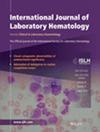Laboratory workflow for optimizing leukocyte count and differential in synovial fluids on Sysmex XN-1000
Abstract
Introduction
Falsely elevated synovial white blood cell (WBC) counts using automated hematology analyzers have been reported particularly in the setting of joint arthroplasty. We evaluated the implementation of a laboratory workflow based on Sysmex XN-1000-automated cell counting and scattergram interpretation.
Methods
WBC and differential were measured for 76 synovial fluid samples (29 native joints and 47 with joint arthroplasties) with Sysmex XN-1000 and manual methods. All scattergrams were evaluated for possible incorrect WBC and/or differential according to our implemented workflow. A specific finding was the “banana-shape” scattergram, which indicates possible interferences. The European Bone & Joint Infection Society (EBJIS) criteria were applied to identify possible prosthetic joint infections (PJIs) in patients with joint arthroplasties.
Results
Correlation between automated and manual WBC counts, calculated for samples with WBC count <50 000/μL, was higher for native joints (r = 0.938) compared with patients known with arthroplasty (r = 0.906). Scattergrams classified as OK showed overall a higher correlation compared with scattergrams, which were interpreted as NOT OK. “Banana-shape” scattergrams (n = 19) showed falsely elevated automated WBC count, and the patterns were mainly seen in prosthesis patients (17/19 [89%]). Six of 47 (13%) patients with joint arthroplasties were reclassified from “confirmed” to “unlikely” PJI according to the EBJIS criteria.
Conclusion
Our workflow based on scattergram interpretation resulted in accurate WBC counts in synovial fluid using automated/and or manual methods. It is important to identify the presence of “banana-shape” scattergrams to avoid overestimated automated WBC counts. Overall, automated synovial WBC count can be used, even for patients with arthroplasty, but after visual inspection of the scattergram to exclude possible interferences.
| 公司名称 | 产品信息 | 采购帮参考价格 |
|---|

 求助内容:
求助内容: 应助结果提醒方式:
应助结果提醒方式:


